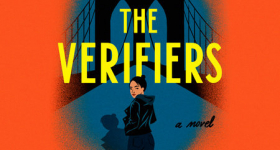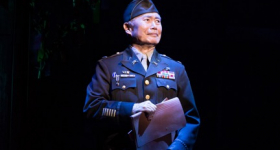Glenn Morey and his wife and co-director, Julie Morey, have spent years conceiving of, producing and directing Side by Side: Out of a South Korean Orphanage and Into the World, a multi-tiered documentary and audio/visual art installation. Focused on changing the narrative of intercultural adoption beyond rescue and compassion, Side by Side documents 100 first-person stories from 100 transracial adult adoptees recounting their deeply personal, singular lived experiences. Since the 1950s, there have been nearly a million of these adoptions, starting with South Korea and peaking in numbers between the ’80s and ’00s. Neither an endorsement or indictment of intercultural adoption, this project provides willing viewers with a window into the oral history of a profound movement in South Korea that continues to shape the country to this day. Hyphen had the chance to speak with Director Glenn Morey about his process and experiences throughout the course of this project.
Can you discuss the release dates of each piece of this installation?
The project launched in May of 2018 and launched as the website and what I would call an immersive, online video installation that essentially gives us the opportunity to feature all 100 stories in a very egalitarian or democratic way. In a way that preserves the authenticity and realness of how these stories are told. The interviews on the website are virtually unedited. It’s all there. The context, as you can understand, is so much of understanding a story like this. So, getting the information in its full context but also getting the information and seeing what it took to tell the story, was really important. It’s what we thought was really the purest and most authentic iteration of the project.
The second thing [we produced] was a short film. We took nine of the stories out of the full project and released them as an edited short documentary film providing a more easily digestible side of the adoption process.
Next, we’ll have a 10-screen video art installation featuring 10 shorts, which will be premiering initially at the Ikaa Gallery in Seoul, about a year from now.
Can you talk to me about your personal background and experience as a Korean adoptee?
I was born and adopted out of South Korea in 1960 at 6 months old and I was likely born in Seoul. After, I was processed through city hall and then ended up very quickly in a Holt orphanage. I was adopted out of there to a family in Littleton, CO. I became the firstborn son of that family. They already had three biological sisters. They adopted one more child from Korea (my brother) and then two more children domestically.
My upbringing was very religious, which is not uncommon given the fact that there was a faith requirement for all adoptions through Holt at the time. I was raised in a white family but also through a community/schooling system that was very white. I don’t think there was another Asian person in all the schools I attended through high school, with the exception of my brother.
I was raised to be nonracial. My parents were told not to treat my brother and I any differently or to dwell on obvious difference.
There are two big pillars of identity. Gender and race. If one is an off-limits topic and something you’re not supposed to even acknowledge, that creates problems later on.
It took a process of self-racialization where you become Korean/Asian but out of your own discoveries in life and as a result of the thing you’re eventually willing to talk about and acknowledge — to the point where you are finally comfortable with your identity as a Korean adoptee. For me, that took 40 years of living and I didn’t come to a place where I had a great deal of comfort with that until my early 40s.
Why is it that you felt compelled to create this piece?
Since 1981 I’ve been a commercial filmmaker. Over the course of that time I also got the opportunity to work on a number of documentary films, including some really cool projects where I became very, very interested in at some point, working on a project that was a documentary but also personal. I never really knew it would be this project or topic because I really didn’t come to an understanding about how I felt about it until my mid-40s. My wife and I retired from the advertising business about six years ago. We sold our agency and we had the opportunity to move onto something new. That’s about the time I was really thinking about where I wanted to go (personally for myself, my wife is not an adoptee) with this whole Korean adoptee community thing, because it had made a big difference in my life. Only by talking to other adoptees had I been able to process and fully come to terms with how I feel about all of this and I’m still doing that to be truthful. So, I really believe that knowing other adoptees, hearing their stories and experiences in their lives, is really critical to thinking about your own. And yet, I think it’s pretty clear that most intercountry adoptees don’t have the opportunity to do that. It would still not add up to more than about 10-15% of all Korean adoptees in the world. All of them with these commonalities that we know about. So, a project like this distributed with the viral and reach power of digital media, was really the only way I could see to effectively take that on.
Can you talk a bit about how the interviews you conducted affected you and what you took away from those conversations?
I think it’s only natural to assume as a Korean adoptee that if there are other Korean adoptees in the world, they had an experience not unlike yours. That they were raised by loving parents in a safe and loving home, to go on and have relationships and families of their own. That is not the case. In fact, the disparity of stories we filmed could not be more unimaginably different from one another. Not everyone in the project was adopted, so that creates a massive difference in experience there. Also, we talked to those adopted at 5, 8 and 12 years old. Adoptees who sometimes had vivid memories of being given away through a car window or simply abandoned on the street. Vivid memories of orphanages. Some good, some very bad. Waving goodbye to their mother through an airplane window. Sometimes giddy to be going on an airplane. Sometimes crying and screaming for hours. We talked to adoptees raised in picture perfect homes. But many were really dysfunctional, twisted and abusive. Some are thrilled with their lives and their relationships and their successes. Some are unfulfilled and faced with homelessness, addiction, attempts at suicide.
The first thing I learned is that there is this tremendous diversity and disparity of stories.
The second thing I learned is that there is this tremendous commonality as well. It’s hard to characterize any sort of reason for separation from families. It’s hard to make sense of your life. Adoption complicates the formation of self-identity and then being adopted transracially takes everything to a whole new level. Virtually every adopted person we talked to talked about how difficult it was to be Korean or Asian. Many used the term self-loathing. A woman we interviewed even experimented with talcum powder in order to minimize her skin color.
These commonalities were very consistent from wonderful adoptive parents to horrible adoptive parents, across varying spectrums of outcomes and views and perceptions of their adoptions.
How did the interview process transpire?
We were very democratic, meaning that we interviewed everyone in the cities that we went to who wanted to be interviewed. We included every interview we filmed. We approached every interview in the same way. We took a loosely structured, first-person narrative approach. They told us what they remembered or what they’d been told about their origins, how they were adopted or aged out. How they grew up and came of age, and who they are today.
Interviews show how spontaneous and how emotional these tellings really were. There were moments where the subject was understanding something about their lives for the first time. Moments where they drew on and lived repressed memories. They were required in their own minds and process to come to some degree of resolution and reconciliation with what they told us, and all of this happened in front of a camera, which makes these stories a tremendous gift on the part of the storytellers in my view. And it placed an incredible responsibility on Julie and me as filmmakers to be democratic and fair in our presentation of the material and to position this project in as non-political and non-judgmental way as possible.
How did you locate and connect with your interviewees?
Social media. A few of the people I interviewed were those I’d met before [via adoptee conferences]. I put it up on social media and immediately was involved in a months-long process of phone interviewing some 500-600 Korean adoptees around the world. And from there, we went through a logistical process by which we tried to determine which cities to go to in order to make the most efficient schedule. We agreed to interview all who wanted to be interviewed in those cities and stopped at 100. If I have a regret, it’s that I didn’t interview hundreds more, but time and money and resources have a way of limiting that.
What would you like viewers to take away from this piece? Why is it important to you?
We’re all familiar with intercountry adoption. We all know a family who has been formed by intercountry adoption. We know a great number of those babies have come from Asia. But the narrative we’re familiar with kind of ends there. The narrative does not continue with what happened to them. What happens when a foreign-born, Asian baby gets adopted by an American family, or a white family in any developed white country in the world? Not only intercountry but transracial. This project exists to tell the stories of 60+ years of intercountry adoption out of South Korea between 1944 and 1955. These are the stories of our separations. The orphanages we were in all the way to who we are today. They are our stories told through our eyes. This is the time, now that so many of us are adults, where we really can begin to understand this history through the eyes of the people it affected the most. It exists to open a window of history and understanding and empathy through first-person storytelling.
Really what I wanted to get out of this project, from the biggest possible to the most selfish introspective reason, is that I wanted an opportunity to become more self-aware. We all need stories to become more self-aware.
I’m beginning to accept and understand my own experiences. I was forever changed by this project and it is the project of my life.
For those who are not as intimately connected to these storylines as Korean adoptees are, why do you think these experiences are worth being conveyed to the larger population? Obviously, there is a large number of Korean adoptees, which warrants some attention, but what about their story do you feel is universally compelling?
People considering adopting a child do so with a narrative in mind and if the only narrative they have in their mind has to do with babies and the love that they would have for that baby and possibly, themes of rescue and compassion, that is an overly simplistic and reductive view of what they’re about to do. From the standpoint of narrative, I think the implications of a truer narrative that is complex and as nuanced and textured and complicated as life really is, it’s important to the subject involving another human being.
Have your thoughts about adoption been altered at all by this piece?
Short of a political statement, this is what is clear to me now: One, that the Korean culture is inextricably tied with intercountry adoption out of Korea and as much as things have changed, some things have not and that’s why intercountry adoption has a 60+ year history.
Two, I believe that it’s good for adoptees ourselves to have a clear and broad-ranging understanding of our population and our group so that we can empathize with them. I think empathy supercedes judgment and so when you hear other peoples’ stories you begin to understand them, and you become reluctant to judge them.
Do you have plans for future productions?
Korea is really only the first country that began sending children abroad to be adopted. Many other countries have followed suit and even though their histories are shorter, those adoptees are younger, they are beginning to become adults. Particularly in countries like China and Vietnam, which have been adopting out for a long time. Those adult communities are beginning to form much like Korea, so I’d love to see those communities undertake projects like this because I think that they’re doable as a project and I think that they can become a great catalyst of understanding. I’d be happy to help those communities embark on a project like this in the future.
Is there anything else you want to add?
This project is not unique in its narrative-changing ambition. We want to be part of a far bigger movement to change the narrative on intercountry adoption. This side of the narrative, the adoptee’s side, is really critical and will create so much more understanding for the future as intercountry adoption continues to be a widespread practice.
To learn more about Side by Side and to view the interviews, you can check out the online video installation on the official website, in which every filmed interview is an individual film, comprising 100 short films and 21 hours of material.
There is also a 38-minute short documentary film featuring nine Korean-born intercountry adoptees, filmed in Paris, Amsterdam, Stockholm, Melbourne, NYC, Boston, Chicago and Seattle.
Premiering in the Ikaa Gallery in Seoul about a year from now, Side by Side will expand its reach to feature a 10-screen video art installation featuring 10 shorts, with hopes of installing it in various U.S. galleries, museums, events and educational institutions.
And finally, a book based on 100 still portraits and the interview transcriptions/translations will be a part of this process as well.
Visit http://sidebysideproject.com/ for more information.










Comments